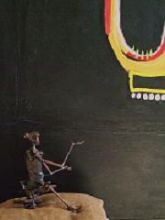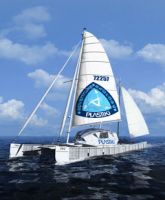The Making of the Eat-fish-(ad)wiser
The Eat-fish-(ad)wiser was an indirect result of my research on plastic waste in our oceans. At one point I found an article on Google describing how mercury particles in the air (mostly originating from coal fired energy plants and other industries) end up in the ocean and accumulate in algae and other micro-organisms. As plastic is a favorite habitat for such small organisms, drifting plastic waste soon is bound to become a veritable mercury mine.
This got me thinking of further links in the food chain, cause fish are known to feed on the prolific plankton tied to nicely visible plastic waste particles. Soon I found myself discovering fish species after fish species that indeed showed high mercury concentrations in various body parts.
Why not systematize the known data for the benefit of consumers, I reasoned. I ran into the American websites of the Environmental Defense Fund (www.edf.org, Health Alert) and the Monterey Bay Aquarium (www.montereybayaquarium.org/cr/seafoodwatch.aspx) providing that very service. But I also discovered that a similar consumers’ guide was lacking for the European market.
So I set out collecting media articles as well as scientific and official government publications dealing with contaminants, both in wild and in farmed fish.
Two important ones were a PhD thesis on contaminants in commercial fish species by the Belgian scientist Isabelle Sioen and the WWF/North Sea Foundation consumers’ tool Viswijzer, ranking fish according to the degree of ‘sustainability’ with which they are caught and/or bred.
I drew up a list of relevant seafood species for European consumers and ranked them according to the measured concentrations I could find in the literature. As I needed to publish without too much delay, I started out confining myself to the two most thoroughly documented types of contaminant: (methylated) mercury and dioxine/PCB-like compounds.
Because consumer safety was my starting point and because so little is known about the effects of all kinds of contamination in fish, I wielded a heavy stick. Even incidental high concentrations, led to a considerably lower safety score.
The Eet-vis-wijzer (Eat-fish-(ad)wiser) therefore is certainly not a scientific publication but a journalist’s piece of work. In the near future I plan to deepen and broaden the underlying data. I need to include several other types of contaminants and make use of many more scientific data from various international sources.
Martial Art

Once they were bullets, pistols or grenades. Now under the deft hands of Mozambique’s possibly most famous sculptor Goncalo Mabunda they have been transformed into Art.
Recycling AK-47's and other arms from the one-time civil war has become the trade mark of Mabunda and a couple of his fellow artists. I saw some of the results in a small B&B in Antwerp. But even the British Museum and the Bill Clinton Foundation acquired pieces from the 'Arms into Art' programme. Read more…
Photo: © Michel Robles
High on FSC

Ten years ago the Netherlands were an admired environmental pioneer nation. Nowadays, due to a shortsighted neoliberal policy we are almost tail-end Charley within the European Union. Belgium, on the other hand, is a real runner-up. Last December (2010) the Flemish Leukenheide distillery presented Dennenknopje (Pine Bud). Dennenknopje is the world’s very first jenever (traditionally a truly Dutch strong drink), made from a Forest Stewardship Council (FSC) labeled wood product. The gin-like softbooze is distilled from pine cones from the Pinus silvestris. The pines grow in Flanders’ vastest, FSC certified forest region Bosland. A local high from an okay forest. Innovation can be anywhere.…
Questioning Plastiki pride
The newly designed cradle-to-cradle catamaran Plastiki has recently arrived is Sidney after a publicity voyage from California across the Pacific Ocean. The designers claim extreme recyclability. But, contrary to earlier announcements, the ship will not be up-cycled now that it has reached its destination. The builders say they've become too attached to their newborn baby. Of course, the vessel can be a showcase for years to come. But, hey, isn't this kind of attachment of people to their achievements precisely the reason why our earth is becoming such a cluttered place? www.theplastiki.com

Sweet C2C
Cradle-to-cradle handmade beauty: go haunt the town's antique and recycle shops and flea markets for a bunch of elegant (or maybe you prefer funny or modern design) plates, saucers and wine glasses. Wash them well, sand the glasses' brims lightly and glue things together with strong porcelain glue. Any shape, size and design you fancy, will do.


Lo and behold: you have now created your own home grown bonbonnière! For sweets, cookies, fruit - or sandwiches if you like. Ladies love'em! Dozens were sold in a fashion shop in my home town. Enjoy more...

Photos: © Michel Robles
Links
Novio Design Webdesign
